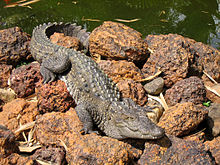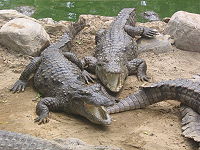- Mugger crocodile
-
Mugger Crocodile 
A mugger crocodile in India. Conservation status Scientific classification Kingdom: Animalia Phylum: Chordata Class: Reptilia Order: Crocodilia Family: Crocodylidae Subfamily: Crocodylinae Genus: Crocodylus Species: C. palustris Binomial name Crocodylus palustris
Lesson, 1831[1]
Distribution of Crocodylus palustris The mugger crocodile (Crocodylus palustris) (literally "crocodile of the marsh"), also called the Indian, Indus, Persian, or marsh crocodile, is found throughout the Indian subcontinent and the surrounding countries. It is one of the three crocodilians found in India, the others being the Gharial and the Saltwater crocodile.[2]
The name "mugger" is a corruption of the Urdu word magar which means "water monster".[3][4] This is in turn derived from makara, the Sanskrit word for crocodile.
Contents
Description
Mugger crocodiles have 19 upper teeth on each side; a snout that is 1⅓ to 1½ as long as broad at the base; a rough head but without any ridges; mandibular symphysis extending to the level of the fourth or fifth tooth; pre-maxillo-maxillary suture, on the palate, transverse, nearly straight, or curved forwards; and nasal bones separating the pnemaxillaries above. Four large nuchals forming a square, with a smaller one on each side; two pairs of smaller nuchals on a transverse series behind the occiput. Dorsal shield well separated from the nuchal, the scutes usually in 4, rarely in 6, longitudinal series, those of the two median usually considerably broader than long; 16 or 17 transverse series. Scales on limbs keeled. Fingers webbed at the base; outer toes extensively webbed. A serrated fringe on the outer edge of the leg. Adult blackish olive above: young pale olive, dotted and spotted with black. The largest specimen in the British Museum measures 3.7 m (12 ft), but individuals are said to grow much larger.[5] On average, females are 2.45 m (8.0 ft) in length and males are 3.05 m (10.0 ft). Old, mature males can get much larger, at up 4–5 m (13–16 ft) and a weight of more than 450 kg (1000 lbs). Although individuals exceeding 4.25 m (13.9 ft) are exceptionally rare, the largest Mugger on record measuring a huge 5.2 m (17 ft) in length.[6] Mugger crocodiles can achieve speed of around 8 mph over a short distance in pursuit of prey.They can swim much faster 10 to 12 mph in short bursts,when cruising they go at about 1 to 2 mph.
Distribution
The mugger crocodile can be found in India, Bangladesh, Sri Lanka, Pakistan, Nepal, the southern tip of Iran, and probably in Indo-China and at one point, even in Southern Iraq. The mugger is the only crocodilian found in Iran and Pakistan. This crocodile is the most common and widespread of the three species of crocodiles in India, far out numbering the much larger saltwater crocodile within the country (and most likely within neighboring countries).
In the 1980s, the largest population of wild crocodiles in Tamil Nadu, South India lived in the Amaravathi Reservoir, and in the Chinnar, Thennar and Pambar rivers that drain into it. Their total population here was estimated to be 60 adults and 37 sub-adults. The Amaravati Sagar Crocodile Farm, Established there in 1975, is the largest crocodile nursery in India. Eggs are collected from wild nests along the perimeter of the reservoir to be hatched and reared at the farm. There were up to 430 animals maintained in captivity at one time. Hundreds of adult crocodiles have been reintroduced from here into the wild.[7] The estimated population in Pakistan is between 400 to 450 animals found in the coastal areas and rivers of Sindh and Baluchistan. The estimated number of animals in Sindh in 160, while in Balochistan the estimated number is 64, while only 24 were seen there, sources in the Sindh Wildlife Department said, requesting anonymity.
On the Iranian Makran coast, above Chabahar are found around 200 mugger corocodiles. They are indigenous to the Sarbaz River, Bahu Kalat River, Kaju and Pishin river basins in Baluchistan province. Due to human activities and that long drought of the late 1990s, early 2000s, the mugger has been pushed to the brink of extinction over the past few years. Following several tropical cyclones such as the Cyclone Gonu and Cyclone Yamyin in 2007, and Cyclone Phet in 2010, much of the habitat of the Iranian mugger crocodiles has been restored as the dry lakes and hamuns have flooded once again. The animal is known as gando in the local Iranian vernaculars.
Habitat
Mainly a freshwater species, the mugger crocodile is found in lakes, rivers and marshes. Muggers prefer slow-moving, shallower bodies of water rather than, fast-flowing, deep areas. Also known to thrive in man-made reservoirs and irrigation canals. Although it prefers freshwater, it has some tolerance to saltwater therefore is occasionally reported from saltwater lagoons. It is sympatric with the gharial (Gavialis gangeticus) in some areas of India and with the saltwater crocodile (Crocodylus porosus) in other areas, but separated by habitat most of the time. It is adapted to terrestrial life like its cousin, the Cuban crocodile, more than most crocodilians, but is ecologically most similar to the African Nile crocodile. It is known to be more mobile on land, can migrate considerable distances over land in search of a more suitable habitat. It can chase prey on land for short distances. They are also known to dig burrows as shelters during the dry seasons.
Diet
Being a large carnivorous reptile, the mugger crocodile eats fish, other reptiles and small mammals, such as monkeys. In fact, most vertebrates that approach to drink are potential prey, and may suffer being seized and dragged into the water to be drowned and devoured at leisure. Large adults will sometimes prey on large mammals such as deer, including the 225-kg sambar deer, and the 450-kg domestic water buffalo. At night they sometimes hunt on land, lying in ambush near forest trails. [8] This species is generally considered to be occasionally dangerous to humans, but nowhere near as notorious as the much larger (and, in India, less common) saltwater crocodile.
References
- ^ Crocodylus palustris IUCN Red List of Threatened Species (1996) Listed as Vulnerable (VU A1a, C2a v2.3)
- ^ Hiremath, K.G.. Recent advances in environmental science. Discovery Publishing House, 2003. ISBN 8171416799.
- ^ Mugger | Define Mugger at Dictionary.com. Dictionary.reference.com. Retrieved on 2011-03-19.
- ^ Britton Adam (2002) Crocodilian species list, retrieved August 30, 2007 Crocodylus palustris
- ^ Boulenger, G. A. (1890) Fauna of British India. Reptilia and Batrachia.
- ^ Crocodilian Species – Marsh Crocodile (Crocodylus palustris)
- ^ Andrews,Harry V., "Status and Distribution of the Mugger Crocodile in Tamil Nadu"[1]
- ^ Dinets, V.L. (2011). "On terrestrial hunting in crocodilians". Herpetological Bulletin: 15–18.
See also
Extant Crocodilian species Kingdom: Animalia · Phylum: Chordata · Class: Sauropsida · (unranked): Archosauria · Superorder: Crocodylomorpha Family Gavialidae Family Alligatoridae Alligatorinae
(Alligators)Caimaninae
(Caimans)Related articles on alligators, caimans, crocodiles and gharials Topics Human
interactionU.S. Alligator fatalities · Crocodile attacks · Alligator farm · Crocodile tears · Famous crocodiles and alligators · Sewer alligatorCategories:- IUCN Red List vulnerable species
- Reptiles of Sri Lanka
- Reptiles of Pakistan
- Fauna of Iran
- Reptiles of India
- Fauna of Bangladesh
- Crocodilians
- Crocodylidae
Wikimedia Foundation. 2010.




